Local Area Labour Markets in Scotland - Statistics from the Annual Population Survey 2013
Summary publication of results from the Annual Population Survey 2013, presenting analysis on the labour market, education and training. Results are provided for Scotland and local authority areas in Scotland.
Section 1: People in Work
Country level analysis
Improving participation in Scotland's labour market is a key driver in meeting the Scottish Government's overarching Purpose of increasing sustainable economic growth.
The latest trends in Scotland's labour market are monitored monthly using the rolling quarterly Labour Force Survey (LFS) and data can be accessed on the Office for National Statistics (ONS) website[3].
The labour market in Scotland and other countries of the UK have continued to recover from the 2008 recession and the subsequent period of slow or static growth that followed. The recovery in 2013 appears stronger than in previous years (since the 2008 recession), and the latest data from the quarterly LFS indicates that this has continued through into 2014, with record employment levels being seen in Scotland and unemployment rates falling below 7.0 in both Scotland and the UK.
Analysis of the latest headline trends, updated monthly based on the LFS, is available from: http://www.scotland.gov.uk/Topics/Statistics/Browse/Labour-Market/AnalyticalPapers
The APS remains the best source for local area labour market trends, as the sample size on quarterly LFS is too small to be used to monitor trends within small sub-groups and within the local authority areas of Scotland.
Figure 1: 16+ working population by employment status, Scotland, 2013
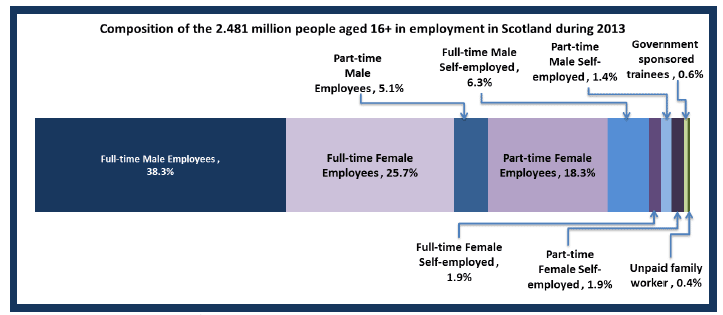
Source: Annual Population Survey, Jan-Dec 2013, ONS
Figure 1 gives an overview of the composition of those aged 16 and over who were resident in Scotland and in employment during January to December 2013.
Local area and sub-group analysis
Employment Rate
Figure 2: Employment rates across Local Authority areas, Scotland 2004-2013
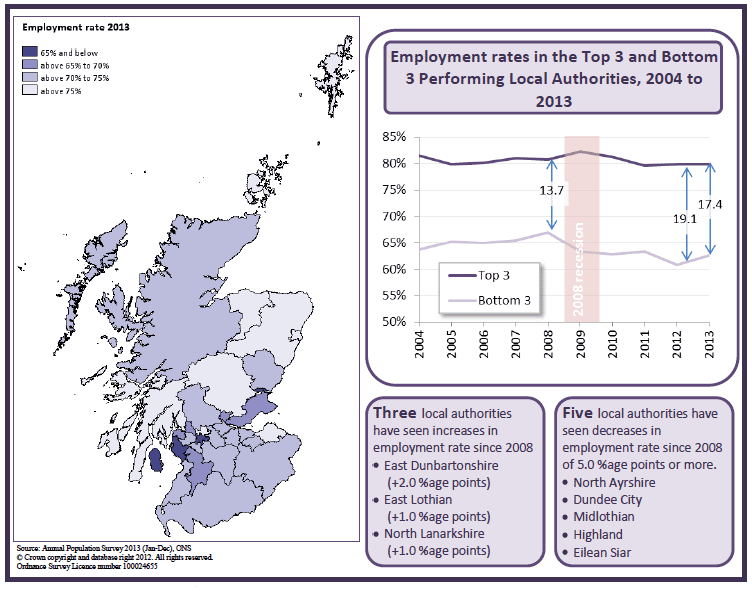
Source: Annual Population Survey, Jan-Dec 2013, ONS
Based on the APS, the employment rate (for those aged 16-64) in Scotland increased over the year by 0.3 percentage point to 71.0% in 2013, while the rate in the UK increased by 0.7 percentage points to 71.3%. Since the 2008 recession, the rate in Scotland has decreased by 2.6 percentage points, a larger decrease than the 0.7 percentage points seen in the UK.
Across the local authority areas of Scotland in 2013:
- The highest employment rates were seen in Shetland Islands, Orkney Islands, and Moray (83.2%, 81.0% and 78.8% respectively)
- The lowest rates were seen in North Ayrshire, Dundee City and Glasgow City (60.1%, 61.4% and 63.3% respectively)
- There are some signs of a geographic trend, with local authority areas in the north generally fairing best, and those in western central belt and south west of Scotland generally fairing worst.
Over the year:
- Employment rates increased in 20 out of 32 local authority areas in Scotland.
- The largest increases were in Argyll and Bute, Inverclyde and Stirling (up 4.6, 4.3 and 3.9 percentage points respectively)
- The largest decreases were in Dundee City, South Lanarkshire and Midlothian (down 3.9, 3.6 and 2.9 percentage points respectively)
Since the 2008 recession:
- Employment rates have decreased in all but 3 local authority areas in Scotland.
- Increases were only seen in East Dunbartonshire, East Lothian and North Lanarkshire (up 2.0, 1.0 and 1.0 percentage points respectively)
- The largest decreases were in North Ayrshire, Dundee City and Midlothian (down 8.8, 8.1 and 5.3 percentage points respectively)
Table 1 in Annex A gives the employment rate for the population aged 16 to 64 in Scotland's local authorities for 2008, 2012 and 2013. A time-series back to 2004 can be obtained from the web-tables at: http://www.scotland.gov.uk/Topics/Statistics/Browse/Labour-Market/Local-Authority-Tables
Chart 1: Employment rates (16-64) by local authority, Scotland, change since 2008
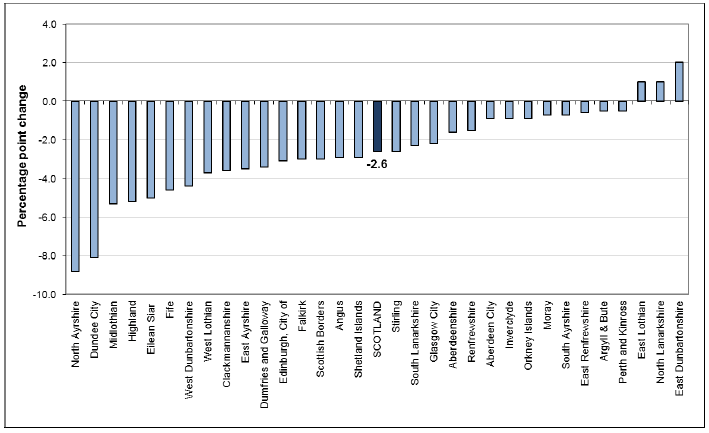
Source: Annual Population Survey, Jan-Dec 2013, ONS
Cohesion
The APS is used to measure progress against the Government's Cohesion target, which aims to narrow the gap in participation between Scotland's best and worst performing regions by 2017. Further information on this and other purpose targets and indicators that use the APS to track their progress is available in Annex B and also from the Scotland Performs website at: http://www.scotland.gov.uk/About/scotPerforms
The employment rate in Scotland varies considerably between local authority areas. The gap in employment rates between the top three and bottom three local authorities decreased by 1.7 percentage points between 2012 and 2013. This has been driven by an increase in the employment rate of the three worst performing areas (an increase of 1.7 percentage points over the year). The employment rate in the three best performing areas is unchanged over the year.
Over the past year, the employment rate in Glasgow increased by 3.6 percentage points, which had a relatively large impact on the overall employment rate of the three worst performing areas due to its size.
Over the longer term the difference in employment rates between the best and worst performing areas had reduced from 17.8% in 2004 to a low of 13.7% in 2008, but saw a sharp increase of 5.8 percentage points in 2009 as the impacts of the 2008 recession were seen . The gap reduced slightly between 2009 and 2011(although these reductions were mainly due to decreases in the employment rates of the three best performing areas), but increased again in 2012. The 2013 data shows a reduction (1.7 percentage points) in the gap on 2012. These trends are illustrated in Figure 2
Analysis by gender
Figure 3: Employment rates by gender for Scotland and UK
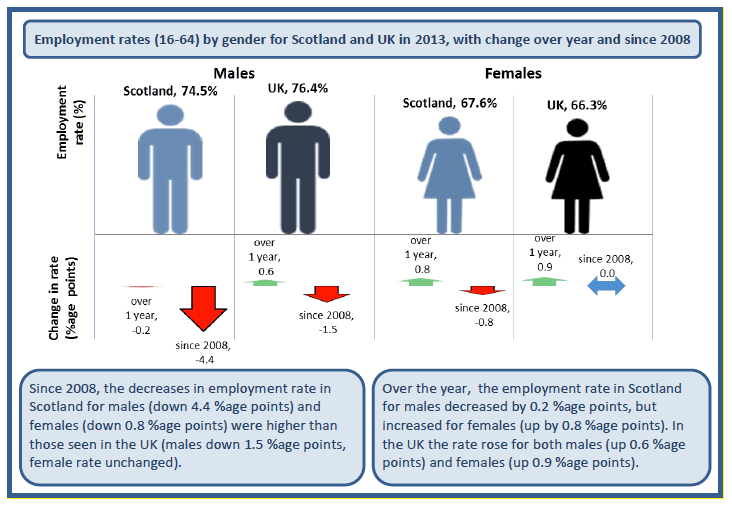
Source: Annual Population Survey, Jan-Dec 2013, ONS
Figure 3 compares employment rates for males and females in 2013, showing change over both the year and since the 2008 recession.
- The employment rate for males has decreased more in Scotland than in the UK since the start of the recession in 2008.
- In 2008, the employment rate for males in Scotland (at 78.8%) was 0.9 percentage points higher than in the UK (77.9%), but in 2013 it was 1.9 percentage points lower.
- The employment rate for females has also decreased more in Scotland than in the UK since the start of the recession.
- However, the employment rate for females in Scotland has generally remained higher than in the UK, and in 2013 was 1.2 percentage points higher, although the gap has now halved since 2008.
- The employment level (16+) for females in 2013 was 1,198,500, up 15,800 over the year, and the highest level seen from the APS since April 2008-March 2009
- The employment level (16+) for males in 2013 was 1,282,800, down 2,100 over the year.
The areas with the highest male employment rates in 2013 were Aberdeenshire, Shetland Islands and Moray (86.9%, 85.7% and 82.6% respectively). The areas with the lowest male employment rates were Dundee City, North Ayrshire and Glasgow City (63.1%, 63.4% and 64.8% respectively).
The areas with the highest female employment rates in 2013 were Shetland Islands, Orkney Islands, and East Dunbartonshire (80.5%, 79.4% and 76.0% respectively). The areas with the lowest female employment rates were North Ayrshire, Clackmannanshire and Dundee City (57.2%, 58.4% and 59.7% respectively).
Over the year:
- The employment rate for males in Scotland reduced by 0.2 percentage points to 74.5%, while females saw a 0.8 percentage point increase in their employment rate to 67.6%.
- The employment rate for males increased in 16 local authority areas, but decreased in 15, and one remaining unchanged. Females saw their employment rate increase in 19 local authority areas, with 12 areas seeing decreases, and one remaining unchanged.
- The largest decreases in the overall employment rate were seen in Dundee City, South Lanarkshire and Midlothian (3.9, 3.6 and 2.9 percentage points respectively). The changes in Dundee City and South Lanarkshire, except Midlothian, were driven by reductions in both the female employment rate (down 4.7 and 4.2 percentage points respectively) and the male employment rate (both down 3.0 percentage points). In Midlothian the change was mainly due to a decrease of 3.0 percentage points in the male employment rate.
Since the 2008 recession:
- The employment rate for males and females in Scotland reduced, although the decrease for males was larger (at 4.4 percentage points) than that for females (down 0.8 percentage points).
- The employment rate for males increased in 5 local authority areas, decreasing in the remaining 27. Females saw their employment rate increase in 9 local authority areas, with 21 areas seeing decreases, and 2 remaining unchanged.
- East Dunbartonshire saw the highest increase in the overall employment rate since the 2008 recession (up 2.0 percentage points). This was due to a rise in both the female employment rate (up 3.2 percentage points) and the increase the male rate (up 0.8 percentage points).
- The largest decreases in overall employment rates were seen in North Ayrshire, Dundee City and Midlothian. For North Ayrshire and Dundee City, larger reductions than the national average were seen in both their male and female employment rates, whereas in Midlothian the overall decrease was driven solely by greater reduction than the national average in the male employment rate.
Gender Employment Gap:
Figure 4 shows how the gender employment gap has changed over time in Scotland and the UK.
Figure 4: Gender Employment Gap for Scotland and UK, 2004 to 2013
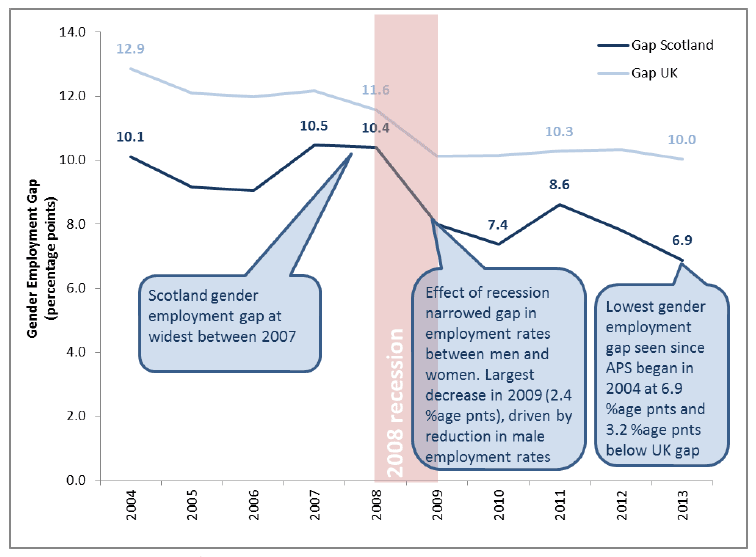
Source: Annual Population Survey, Jan-Dec 2013, ONS
- The gap between male and female employment rates in 2013 was 6.9 percentage points, the lowest seen since 2004 (when the APS started) and 3.2 percentage points lower than that in the UK as a whole.
Employment levels and rates by gender for 2004 to 2013 are provided in the web tables.
Analysis by age group
Figure 5 compares the employment rates across age groups and gender in Scotland for 2013 and shows change since the start of the 2008 recession.
The lowest employment rates are seen by those aged 16-24, 50-64 and 65+.
16-24 year olds are more likely than other age groups to be in full-time education, whereas those in the 50-64 and 65+ age groups are more likely to be retired or long-term sick or disabled.
Figure 5: Employment rates by age and gender, Scotland
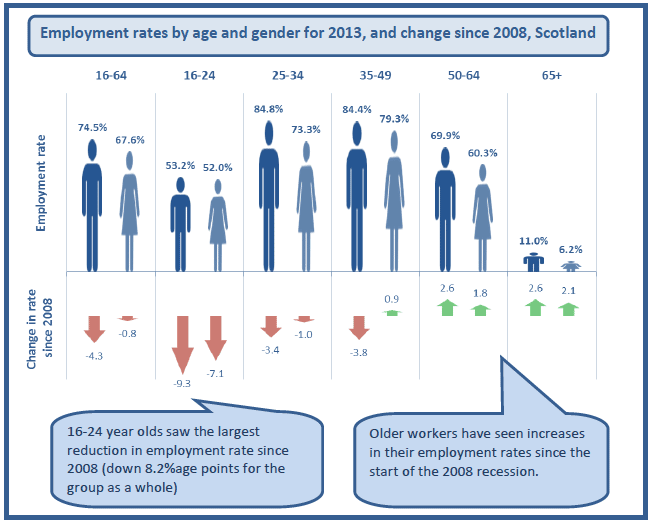
Source: Annual Population Survey, Jan-Dec 2013, ONS
Over the year:
- All age groups in Scotland saw small increases in their employment rates (between 0.1 and 1.0 percentage points) except for those aged 16-24, who saw a reduction of 0.6 percentage points in their employment rate.
- Those aged 50-64 saw the largest increase over the year, at 1.0 percentage points.
- The 16-64 rate increased marginally over the year by 0.3 percentage points.
- Due to the small sample sizes in many local authority areas when looking at employment rate split by age group, variability can be high and reliability of the estimates can be low. These estimates should be used with caution, but may provide longer term indications of movement when examined over several years. Statistically significant[4] changes seen over the year were:
- The increase for 16-24 year olds in East Renfrewshire (up 12.4 percentage points) and the increase for 16-24 year olds in Inverclyde and Stirling, both up 12.9 percentage points.
- The decrease for 16-24 year olds in Edinburgh (down 12.5 percentage points).
- The increase for 35-49 year olds in East Dunbartonshire (up 5.6 percentage points).
- The decrease for 35-49 year olds in Dundee (down 10.1 percentage points).
Since 2008:
- The employment rate for all age groups in Scotland decreased, except for those aged 65+, who saw a 2.4 percentage point increase in their rate. 16-24 year olds saw the largest decrease (down 8.2 percentage points), while the 25-34, 35-49 and 50-64 age groups saw decreases of 2.1, 1.4 and 0.3 percentage points respectively.
- Across all age groups, except older workers (50+), the changes in the employment rate since 2008 are larger for males than for females as illustrated in Figure 5. This may indicate a greater degree of stability in women's employment or that males (or the jobs they hold) react faster to changes in labour market conditions.
- Due to the small sample sizes in many local authority areas when looking at employment rate split by age group, variability can be high and reliability of the estimates can be low. These estimates should be used with caution, but may provide longer term indications of movement when examined over several years. Statistically significant[3] changes seen since 2008 were:
- The decreases for 16-24 year olds in East Ayrshire, Edinburgh, Fife, Glasgow City, North Ayrshire, North Lanarkshire and South Lanarkshire (down 13.8, 16.3, 11.8, 9.9, 14.1, 10.5 and 11.9 percentage points respectively).
- The decreases for 25-34 year olds in Highland and North Ayrshire, (down 14.8 and 13.0 percentage points respectively)
- The decreases for 35-49 year olds in Clackmannanshire, Dundee City and North Ayrshire (down 13.3, 17.9 and 7.2 percentage points respectively)
- The increase for 35-49 year olds in East Renfrewshire and Orkney Islands (up 6.5 and 11.9 percentage points)
- The increases for 50-64 year olds in East Lothian and Perth and Kinross (up 11.2 and 7.7 percentage points)
Further information for the 16-24 year old group is given in the Youth employment section below.
Employment levels and rates by age for 2013 are provided in Table 2 in Annex A, with full time series data from 2004 to 2013 available in the web tables.
Youth Employment (16-24 year olds)
Estimates of youth employment, unemployment and inactivity in Scotland are released on a monthly basis by the ONS. Secondary analysis from the Scottish Government and a link to the primary ONS regional analysis can be found on the Statistical Briefing section of the Labour Market Statistics section of the Scottish
Government website: http://www.scotland.gov.uk/Topics/Statistics/Browse/Labour-Market/AnalyticalPapers#Youth_Unemployment_Publications_and_Briefing_Papers
These estimates are based on rolling quarterly Labour Force Survey (LFS) data. Due to relatively small sample sizes the LFS estimates cannot be broken down to give reliable youth employment estimates by local authority, occupation or industry. However, it is possible to produce this type of analysis using data from the APS.
The youth employment rate in Scotland decreased by 0.6 percentage point over the year; from 53.2% in 2012 to 52.6% in 2013. In the UK, the youth employment rate increased by 0.1 percentage point over the year to from 49.7% in 2012 to 49.8% in 2013. The youth employment rate in Scotland was 2.8 percentage points higher than in the UK in 2013.
Figure 6: Youth Employment across Scotland and compared to UK
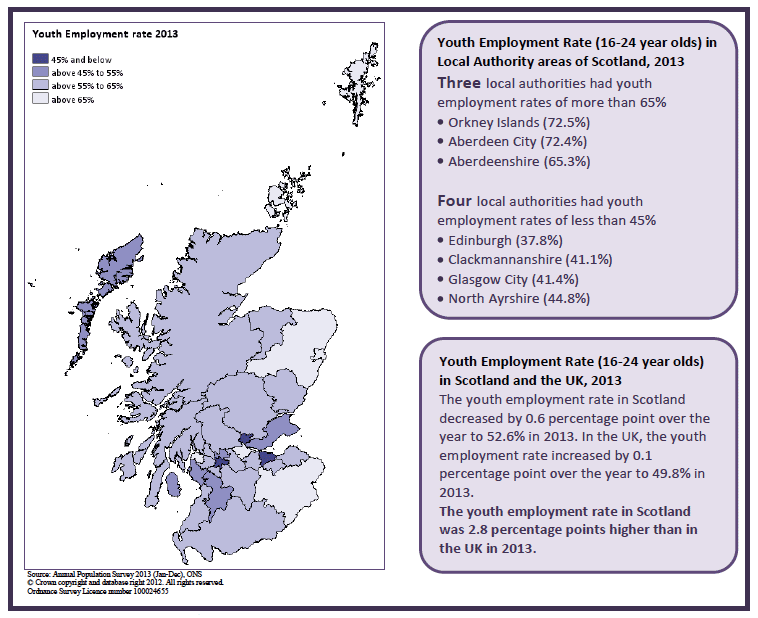
Source: Annual Population Survey, Jan-Dec 2013, ONS
The largest decreases in youth employment rate over the year were seen in Edinburgh, Eilean Siar and Highland
- In Edinburgh this is being driven by an increase in the number of inactive students aged 16-24, up 1,300 from 25,100 to 26,400, which has increased the inactivity rate for 16-24 year olds in Edinburgh from 39.7% to 47.3% over the year.
- A similar effect has also been seen in Highland, where the number of inactive students aged 16-24 has increased by 800 from around 3,400 to 4,200, which has increased the inactivity rate for 16-24 years in Highland from 27.4% to 37.0% over the year.
- It is not possible to perform a similar analysis for Eilean Siar due to the small sample sizes and changes for many of the inactive groups over the year.
Note that in some local authorities there is a large student population which may be expected to lead to higher inactivity among 16-24 year olds and hence lower employment (and unemployment). 44% (260,000) of 16-24 year olds in Scotland were enrolled in full-time education, slightly higher than in the UK (43%). It is important to note that 32.5% of these full-time students in Scotland were also in employment in 2013 (down 1.6 and 8.1 percentage points over the year and since 2008 respectively). This is higher than the percentage in the UK as a whole, where 25.6% of full-time students were also in employment in 2013 (down 0.5 and 6.6 percentage points over the year and since 2008 respectively). Due to sample size limitations it is not possible to look at local authority employment rates by enrolment in full-time education.
Analysis by disability
Disability analysis is not possible from the APS Jan-Dec 2013 dataset due to significant changes to the disability related questions in the LFS survey in the April-June 2013 quarter. These changes are intended to reflect the respondent's ability to carry out day-to-day activities while taking medication, whereas previously, the question was considered for the situation where the respondent did not take medication. Further analysis will be released once a dataset with a consistent set of questions is available for the full year. Further information is available here.
Analysis by qualification level
There is a strong link between educational attainment and employability. As shown in Figure 7, employment rates in Scotland for those whose highest qualification was HNC/HND or above (SVQ 4 or equivalent and above) in 2013 were almost double those whose highest qualifications were General Standard Grade or lower (Below SVQ level 2 or equivalent) and just over 13 percentage points higher than those whose highest qualifications were Higher, A-Level or Credit Standard Grade or equivalent (SVQ 2 or 3 or equivalent).
Examining the trends at Scotland level, it can be seen that employment rates across all qualifications levels have been generally flat or decreasing since 2007, but that:
- The proportion of all those aged 16-64 in employment whose highest qualification was HNC/HND or higher (SVQ level 4 and above or equivalent) has increased steadily each year since 2004.
- Those with SVQ level 4 qualifications and above (or equivalent) are now the largest group within the workforce in Scotland, accounting for 45.4% of the working population aged 16-64, compared to 40.7% for those whose highest qualifications were Higher, A-Level or Credit Standard Grade or equivalent.
- In the UK as a whole those with Further or Higher Education qualifications accounted for 40.9% of the working population aged 16-64, while those with Higher, A-Level or Credit Standard Grade or equivalent was the largest group accounting for 43.9%.
Figure 7: Employment (16-64) by qualification level, Scotland
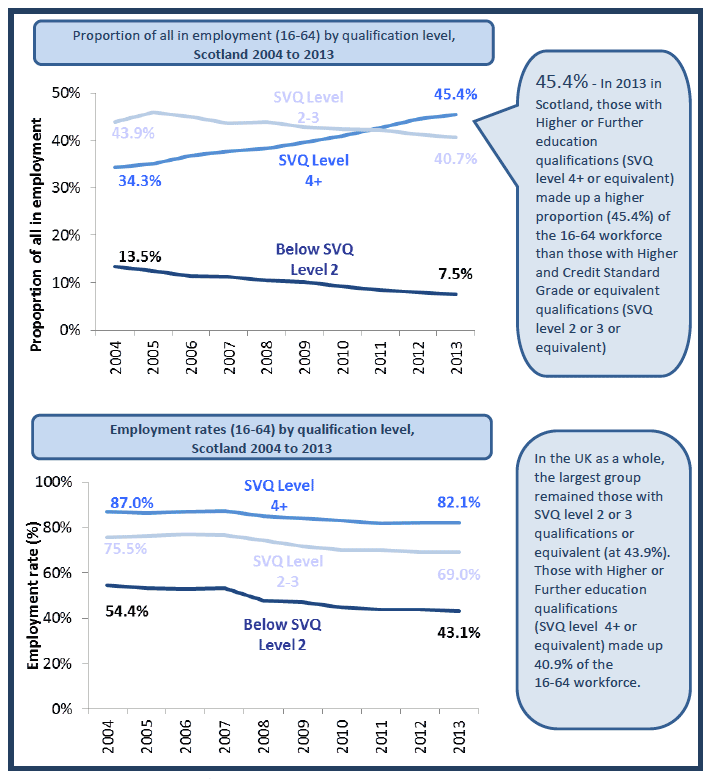
Source: Annual Population Survey, Jan-Dec 2013, ONS
The proportion of those in employment with qualifications below SVQ Level 2 or equivalent have decreased steadily since 2004 from 13.5% (a level of 322,200) to 7.5% in 2013 (a level of 181,500). However, over this period their employment rate has also dropped from 54.4% to 43.1%. Although the number of people in Scotland (16-64) who have qualifications lower than SVQ 2 or equivalent has decreased by 29% since 2004, the number in this group who are employed has decreased at a faster rate (43.7%) reflecting the increased difficulty that those in this group have in securing employment in competition with those with higher qualifications.
Employment levels and rates by qualification levels for 2013 are provided in the web tables.
Graduates
For the purposes of this chapter, a 'graduate' is defined as a person with a degree-level qualification or higher. The analysis focuses on those aged 25-64 as many young people under 25 may still be working towards a degree level qualification.
Table 3 in Annex A shows graduates as a proportion of those in employment by local authority of residence. Graduates as a proportion of those in employment continued to increase steadily during the economic downturn, from 25.1% in 2008 to 31.6% in 2013.
Interpreting this measure at local authority level is more difficult due to the links with employment and commuting patterns. We would expect to see relatively high percentages in local authorities with high numbers of graduate level jobs (i.e. cities) and in any neighbouring local authorities with good commuting links.
- All the city authorities had relatively high proportions of graduates.
- Edinburgh, East Dunbartonshire and Glasgow City had the highest proportions of graduates in 2013 (49.9%, 45.6% and 42.6% respectively).
- North Ayrshire, Orkney Islands and North Lanarkshire also had the lowest proportions of graduates in 2013 (17.2%, 19.0% and 19.7% respectively).
- All authorities have seen their proportion of graduates increase since 2008, with the exception of East Renfrewshire, which has seen a decrease of 1.4 percentage points. Glasgow City has seen the largest increase in proportion of graduates since 2008 of 14.3 percentage points from 28.3% in 2008.
Taking account of the trends in Table 3 and the web-table for employment rates by qualification level, it can be seen that:
- The number of graduates in employment has continued to rise each year since 2004. In 2013 there were 703,700 graduates aged 16-64 in employment in Scotland, up 17,500 compared to 2012.
- The employment rates for graduates in 2012 was 84.2%, 2.1 percentage points lower than in 2008, but up just 0.4 percentage point over the year.
- Graduates, similar to those with other qualification levels, have found it more difficult to obtain employment since the recession, but graduate employment rates are still higher than those for all other qualification levels.
Modern Apprentices (MA)
In 2013, the employment rate for all adults holding any apprenticeship qualification (including traditional, trade or MA) in Scotland was 80.4%, 9.4 percentage points higher than the overall rate in Scotland. For those holding a Modern Apprentice[5] qualification, the employment rate was 91.1%, just over 20 percentage points higher than the overall Scotland rate. (Note that due to changes in the LFS questionnaire, this estimate is based only on those who started their apprenticeships in the year 2000 or later).
Occupational Skill Level (SOC 2010 Classifications)[6]
The ONS defines occupational skill levels using the following criteria:
Box 1 - Occupational Skill Levels
Skill levels are approximated by the length of time deemed necessary for a person to become fully competent in the performance of the tasks associated with a job. This, in turn, is a function of the time taken to gain necessary formal qualifications or the required amount of work-based training.
Low Skill - requires a general education, signalled via a satisfactory set of school-leaving examination grades.
Typical low skill occupations include: elementary personal service occupations (e.g. bar staff, waiters/waitresses) and elementary cleaning occupations.
Medium-Low Skill - requires knowledge provided via a good general education as above, but will typically have a longer period of work-related training or work experience.
Typical medium-low skill occupations include: sales assistant, retail cashier and healthcare/personal service occupations (e.g. auxiliary nurse, home carer).
Medium-High Skill - requires a body of knowledge associated with a period of post-compulsory education but not to degree level.
Typical medium-high skill occupations include: health associate professional occupations (e.g. nurse, midwife, paramedic) and construction trades.
High Skill - requires a degree or equivalent period of relevant work experience.
Typical high skill occupations include: teaching and functional management (e.g. in finance, marketing, public relations, personnel or information technology).
The occupational skill distribution for each of the key age groups in Scotland is shown in Chart 2 below.
Chart 2: Occupational skill level by age group, Scotland, 2013
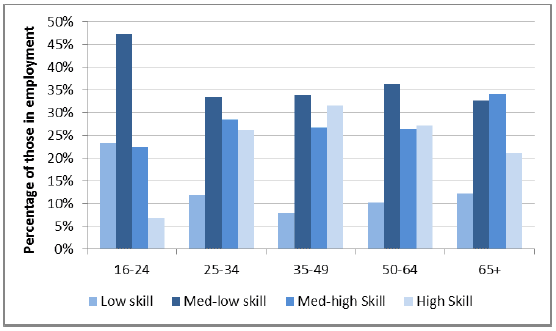
Source: Annual Population Survey, Jan-Dec 2013, ONS
Referring to Chart 2, it can be seen that:
- Distributions are broadly similar across the key age groups.
- About two-thirds of all employees are in medium-low and medium high skilled occupations and a minority (just over 10%) are in low skilled occupations.
- Distribution for the 16-24 year old age group is different.
- Relatively low percentage of employees in high skill jobs (7%).
- Relatively high percentage in low and medium-low skill jobs (23% and 47% respectively).
Chart 3: Occupational skill level by enrolment in full-time education, 16-24 year olds, Scotland, 2013
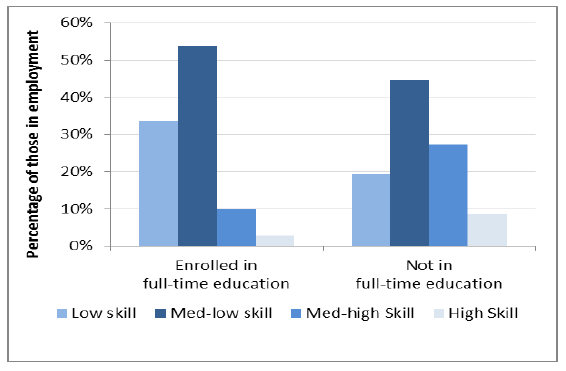
Source: Annual Population Survey, Jan-Dec. ONS
The different distribution for 16-24 year olds may be explained by the fact that it takes time to acquire the relevant qualifications and experience required for high skill occupations. Comparing the occupational skills distribution for the 16-24 year old age group based on whether they are currently enrolled in full-time education or not, highlights some interesting differences as illustrated in Chart 3. The percentage in low and medium-low skill occupations is higher for those enrolled in full-time education, whilst the percentage in medium-high and high skill occupation is lower. Regardless of whether they are enrolled in full-time education or not, young people are most likely to be employed in elementary occupations (kitchen/catering assistants and waiters/waitresses) or sales and customer service occupations. These two occupational groups account for over two-thirds of all employed young people who were in enrolled in full-time education, but just under two-fifths of those not enrolled in full-time education. In addition, the majority (around 90%) of those working young people enrolled in full-time education were employed on a part-time based (to fit around study), compared to about a quarter of those of those not enrolled in full-time education. Those working alongside study are therefore likely to be low-skill choose jobs that have the flexibility to fit around their education and study requirements, but they may still develop some valuable work experience for future careers.
Although the shape of these distributions have been broadly consistent over recent years, examining the decrease in employment levels for 16-24 year olds between 2008 and 2012 shows that:
- Almost all of the decrease was accounted for by those not in full-time education (down 49,200 since 2008, an 18% decrease in level).
- This was mainly due to decreases in employment in medium-low skill occupations (down 30,200, a decrease of 23% in level) and medium-high skill occupations (down 17,100, a decrease of 22% in level).
- In contrast, the employment levels for all 16-24 year olds enrolled in full-time education decreased by 10,400 (a reduction of 11% in level) over the same period.
Work Patterns
Figure 8: Work patterns in Scotland in 2013 and changes since 2008
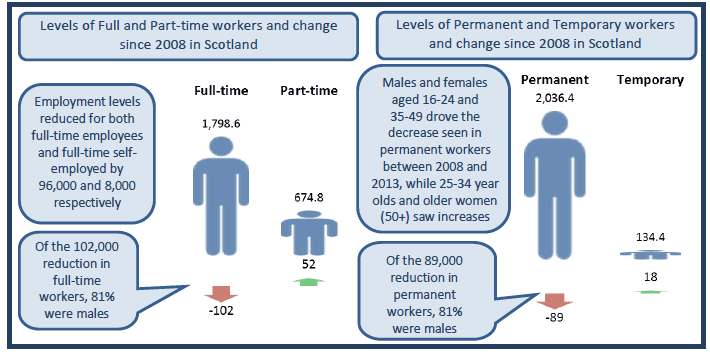
Source: Annual Population Survey, Jan-Dec
The 2008 recession and subsequent slow recovery has changed the working patterns of many in employment in Scotland.
- In 2013, 72.7% of people in employment (aged 16+) were working full time[7] , compared to 75.3% in 2008 (down 2.6 percentage points). The proportion in part-time employment has risen from 24.7% in 2008 to 27.3% in 2013.
- The number of males working full-time in Scotland was just over 1.11 million. The proportion of males in full-time employment was up by 0.4 percentage points over the year to 87.0% but down 3.0 percentage points since 2008.
- The number of females working full-time in Scotland was just over 685,000. The proportion of females in full-time employment in 2013 was 57.4%, up by 1.0 percentage points over the year but down 1.6 percentage points since 2008.
- Stirling, South Lanarkshire and Glasgow City have seen the largest decreases in their proportions of full-time workers since 2008 (down by 6.1, 5.9 and 5.8 percentage points respectively).
- Eilean Siar, Aberdeen City and East Renfrewshire have seen increases in their proportion in full-time work since 2008 (up 4.3, 3.1 and 0.1 percentage points respectively). All other authorities have seen decreases since 2008.
Levels of self-employment had been rising very gradually in Scotland between 2004 and 2010, but rose more rapidly in 2011 and 2012. In 2013, the level of self-employment dropped back to a level similar to that seen in 2011.
- At the start of the recession in 2008, 268,500 (10.6%) of the 16+ workforce were self-employed.
- By 2012, the level of those self-employed had increased to 301,700 (12.2%), but over the year to 2013 their levels have decreased by 15,800 to 285,900.
- This was dominated by a decrease in male full-time self-employment, although male part-time self-employment levels also decreased. In contrast, full and part-time self-employment levels for females were almost unchanged over the year.
- By comparison, the level of 16+ employees has decreased from 2,242,600 in 2008 to 2,172,000, a decrease of 70,600.
- Since the recession, the proportion of the workforce who were self-employed has increased in 22 of Scotland's local authority areas, and decreased in the remaining 8 areas.
- The largest increases in the proportion who were self-employed were seen in Highland, Orkney Islands and Midlothian (up 4.9, 4.9 and 4.4 percentage points respectively).
- The largest decreases were seen in Moray, Dundee City and North Lanarkshire (down 2.8, 2.6 and 2.3 percentage points respectively).
Levels and percentages for full-time/part-time employment, self-employment and workers with second jobs at Local Authority level are available in the web tables.
As well as examining the overall employment rate and people's working patterns, it is useful to look at those who are underemployed: that is, those who are already in employment, but who would prefer to work more hours than they actually do (see Box 2 for full definition). Underemployment can provide an indication of underutilisation of labour. The term "underemployment" is also used to refer to an under-utilisation of skills, however, this is not simple to measure and views of this type of underemployment may differ between employer and employee. At present, the LFS does not directly gather any information on skills related underemployment.
Box 2 - Definition of underemployment
Underemployment includes all employed persons aged 16 and over who during the reference week were willing to work additional hours, meaning that they:
- wanted another job in addition to their current job(s), or
- wanted another job with more hours instead of their current job(s), or
- wanted to increase the total number of hours worked in their current job(s).
Using the definition in Box 2:
- In 2013 there were 234,100 workers who were underemployed (down 9,300 over the year), 9.6% of all employed people over 16 (down 0.4 percentage points over the year).
- The underemployment level has increased by 59,600 since 2008, while the underemployment rate[8] increased by 2.6 percentage points over the same period.
- Over the year, the underemployment rate for 16-24 year olds decreased by 10,100 (2.6 percentage points).
- Underemployment rates are generally higher for women (this reflects the higher prevalence of part-time work amongst women). In 2013, the underemployment rate for men was 9.0% - up 2.9 percentage points since 2008 - while the rate for women was 10.1% - up 2.2 percentage points since 2008.
Chart 4: Underemployment levels by gender and work patterns, Scotland, 2004 to 2013

Chart 4 shows notable changes in underemployment levels between 2012 and 2013 compared with the trend seen since the recession in 2008. Female part-time underemployment in particular fell sharply between 2012 and 2013, down 11,700 (2.1 percentage points). For full-time male workers, the level of underemployment increased by 6,000 (0.5 percentage points) between 2012 and 2013, while the level of female full-time underemployment decreased by 3,000 (0.6 percentage points).
Underemployment data for those aged 16 and over for each local authority in Scotland are given in Table 4 in Annex A. A full time-series back to 2004 is provided in the web tables
Employment by Industry and Sector
Analysis by Industry - Standard Industrial Classification (SIC) 2007
Note that the preferred source for industry employment estimates at local authority level is the Business Register Employment Survey (BRES). Due to the way social surveys and business surveys are collected, there will be differences in estimates from the APS and BRES (industry sector is self-classified in the APS). The latest BRES data for Scotland's Local Authorities is available at: http://www.scotland.gov.uk/Topics/Statistics/Browse/Labour-Market/DatasetsEmployment
Based on the APS, in Scotland in 2013:
- The largest industry was 'Public administration, education and health', employing 31.2% of all workers. Note that this is not equivalent to the Public Sector.
- The smallest industry was 'Agriculture and fishing' with 1.7% of total employment.
- Over the year there have been no statistically significant[9] changes in the proportions employed within each industry sector.
- Since 2008, there have been statistically significant changes in the proportions employed within 'Manufacturing' (down 1.9 percentage points), 'Construction' (down 2.7 percentage points), 'Banking, finance and insurance' (up 3.3 percentage points) and 'Other services' (up 0.7 percentage points). Chart 5 illustrates these changes broken down by gender.
Chart 5: Change in the percentage employed within each industry sector between 2008 and 2013 by gender, Scotland
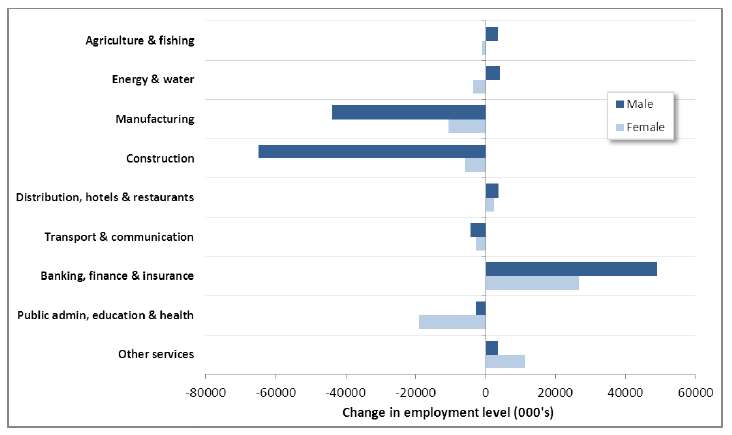
Source: Annual Population Survey, Jan-Dec 2013, ONS
- The majority of the change seen in the 'Manufacturing', 'Construction' and 'Banking, finance and insurance' since the start of the recession in 2008 were due to changes in the number of male workers, whereas, the majority of the change seen in 'Other services' sector since the start of the recession in 2008 was due to changes in the number of female workers.
Impact at Local Authority area level between 2008 and 2013:
- The national reduction in 'Manufacturing' was driven by reductions in Fife, Glasgow and South Lanarkshire (down 8,700, 7,700 and 6,100 respectively), which, combined, accounted for just over 40% of the decrease in this sector.
- The largest declines within the 'Construction' sector were seen in Glasgow and Edinburgh (down 10,400 and 8,600 respectively). However, decreases of over 1,000 were seen in 22 areas during this period, indicating a widespread impact.
- Increases in the level of those employed in 'Banking, Finance and Insurance' within Glasgow City, Aberdeen City and Edinburgh (up 17,200, 7,400 and 7,400 respectively) together accounted for just over 40% of the total rise seen at national level in this sector.
- Glasgow City and Aberdeen City (up 5,800 and 3,900 respectively) and North Lanarkshire and Edinburgh (up 3,900 and 3,100 respectively) together accounted for almost all of the total increase seen in employment within 'Other Services'.
Employment data by industry for each local authority in Scotland is provided in the web tables.
Public, Private and Third Sector analysis
Note: There is a difference in headline Public/Private/Third sector employment levels reported in this section to those reported when looking at Public/Private sector only. This is mainly due to a small number of self-employed respondents being classified in categories which are public sector. However, these are correctly classified during the Public/Private only analysis.
Box 3 - Public Sector Employment
The official source for employment in the public sector at national & regional level is the Quarterly Public Sector Employment series (QPSE). This data is based on administrative data from the various government organisations and bodies that make up the public sector and is based on the National Accounts definition of the public sector.
Sources for QPSE in Scotland: http://www.scotland.gov.uk/Topics/Statistics/Browse/Labour-Market/TrendPublicSectorEmp
The preferred source for estimates of public sector employment disaggregated by gender or age is the Annual Population Survey (APS). Where estimates are reliable, the APS can provide estimates of public/private sector employment by gender or age-group at local area level. However, it should be noted that due to self-classification, the APS tends to over-estimate the size of the public sector.
This is only the second time that this publication series has presented third sector workforce statistics alongside those for the private and public sectors and helps to place them in the context of the wider workforce figures. The great advantage of the APS data is that it provides a consistent time series since 2004 and provides data on the characteristics of those employed in the sector.
Box 4 - Third sector workforce statistics
Estimates of the third sector workforce derived from the APS are generally lower than the estimates produced from other sources and methodologies, for a number of reasons:
- Estimates of the third sector workforce will depend on the definition of sector used. The APS definition of the third sector includes those that work in charities, private trusts, housing associations or other voluntary organisations. Due to the way the data is collected, these estimates will also include employees of Trade Unions. It does not include government funded bodies and agencies, such as National Museums and Art Galleries, or Churches.
- The APS data relates only to a person's main job therefore individuals who have a secondary job in the sector are not included in the estimate. Although the APS does collect some information about people's second jobs, it does not gather the information required to determine if these jobs are in the third sector.
- The APS relies on respondents self-reporting the type of organisation that they work for. It is possible that some respondents may be unsure about the definition of the organisation for which they work.
- The APS is a household survey. Estimates based on surveys of organisations are likely to include an element of double counting as they count the number of jobs rather than the number of workers, as workers may have more than one job in the sector.
Based on the APS for Jan-Dec 2013:
- The Private sector employed 69.6% (1,710,300) of the population aged 16+ in Scotland, with the Public sector employing 27.1% (665,000) and the Third sector 3.3% (81,700).
- Over the year, the only sector to experience increases in their levels of employment was the Private sector (up 18,000). Both Public and Third sector employment saw decreases to their levels of employment, by 500 and 3000 respectively. Decreases seen in the Third sector were driven solely by a fall in numbers of those in part-time employment (down 3,900).
- Since 2008, employment levels in both Public and Private sectors have decreased (down 56,800 and 16,300 respectively), while employment levels in the Third sector increased (up 7,800), with those in full-time employment making up the majority (just under two-thirds) of this rise.
- While the majority (59%) of those employed in the Private sector are males, females accounted for the majority (64%) of all those employed in both the Public and Third sectors.
- People employed in the Third sector are more likely to work part-time than in the Private or Public Sectors (36% of those employed in the Third sector, compared to around 27% for those employed in the Private and Public sectors).
Figure 9: Comparison of Public, Private and Third sectors
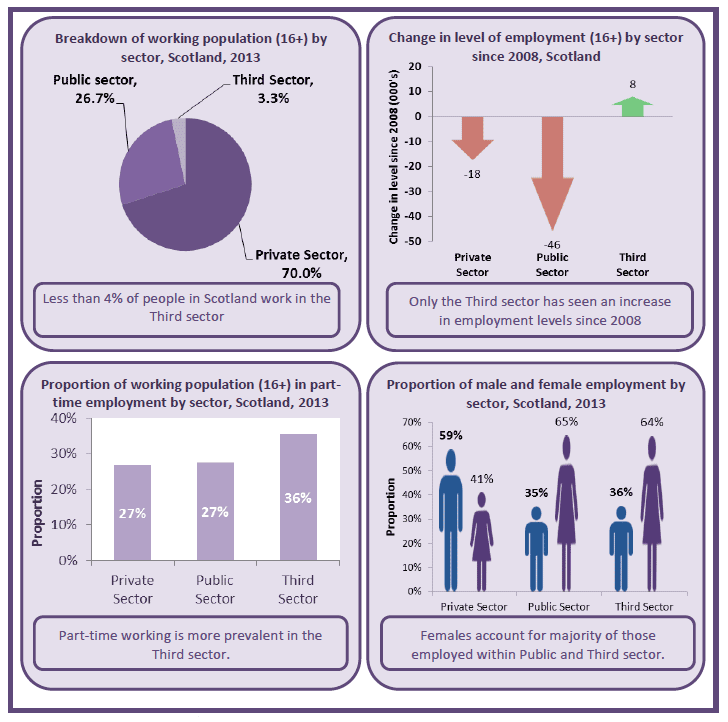
Source: Annual Population Survey, Jan-Dec 2013, ONS
Employment data by Public/Private/Third sector in Scotland is provided in the web tables.
Public/Private sector analysis
Chart 6: Public and Private employment levels (indexed to 2004), Scotland
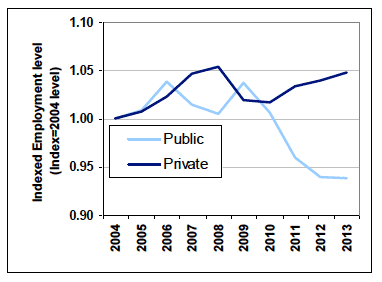
Source: Annual Population Survey, Jan-Dec. ONS
Private sector employment decreased at a faster rate between 2008 and 2009, reacting more rapidly to the recession, whereas public sector employment did not start to decrease until 2009 to 2010.
The latest data indicates that, although the level of private sector employment has not yet returned to its 2008 peak, its level now exceeds that in all other years since 2004. Public sector employment levels have continued to contract through 2013.
Figure 10: Work patterns in the Private and Public Sector, Scotland 2013
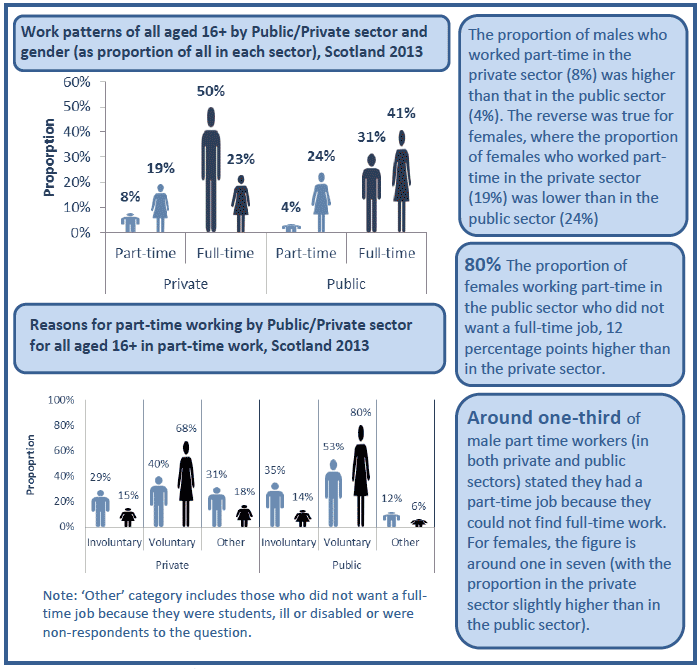
Source: Annual Population Survey, Jan-Dec 2013, ONS
Based on the APS for 2013, over the year, Public Sector employment levels decreased, while Private sector employment levels increased.
- The reduction in Public sector employment between 2012 and 2013 (down 600) is much lower than that seen in the previous three years, when decreases of greater than 10,000 were seen.
- However, while the level for males working in the Public Sector has decreased by 4,900 over the year, females have seen their level increase by 4,400.
- Females accounted for just over two-thirds (10,600) of the 15,000 increase in Private sector employment.
An analysis of working patterns within the Private and Public Sectors in 2013 is shown in Figure 10. This shows that:
- Part-time work is slightly more common for males working in the private sector, but for females part-time work is more prevalent in the public sector.
- Around 80% of women working part-time in the public sector were not looking for full-time work.
- Around one in three men who worked part-time (in both private and public sectors) were doing so as they could not find full-time work.
Over the year, there is considerable variation in the change in public and private sector employment levels for local authorities, with some areas seeing losses in both sectors, while others have seen increases in one sector, but decreases in the other.
- East Dunbartonshire, East Lothian, East Renfrewshire, Eilean Siar, Glasgow City, Inverclyde, Scottish Borders, Shetland Islands and Stirling all saw increases in both public and private sector employment levels.
- Glasgow City saw the largest combined increase in public and private sector employment (up 10,800).
- Increases in public and private sector employment were driven by rise in female employment in both sectors. Public sector employment increased by 4,300, of which 60% was attributable to rise in the number of female employees (up 2,600). Similarly the 6,500 increase in private sector employment was dominated by a 5,000 rise in level for females (with the male level increasing by 1,500).
- Four local authorities (Dundee City, North Ayrshire, South Lanarkshire and West Dunbartonshire) saw decreases in the levels of both public and private sector employment.
- South Lanarkshire saw the largest combined decrease in public and private sector employment levels.
- The decrease in public sector employment of 1,400 was solely as a result of 2,800 decrease in the level for females (with males increasing by 1,300). However the 3,700 decrease in private sector employment was dominated by a 3,000 reduction in the level for males (with a corresponding decrease in female level of 800).
Looking at the change in public and private sector employment since the start of the recession in 2008 shows a somewhat different picture, with both Public and Private sector employment having decreased (down 46,000 and 9,700 respectively).
- Aberdeen City and Perth and Kinross were the only local authorities to see an increase in both public and private sectors over this period; public sector employment increased by 1,600 and 1,200 respectively, while private sector employment rose by 6,300 and 2,300 respectively.
- 15 local authorities saw decreases in the levels of both public and private sector employment. Those which saw the largest decreases in their combined levels of public and private sector employment were North Ayrshire (public sector down 3,900 and private sector down 6,300), Fife (public sector down 200 and private sector down 7,800) and Glasgow City (public sector down 4,100 and private sector down 2,200).
Employment data by public and private sector for each local authority in Scotland is provided in Table 5 in Annex A, with full time series back to 2004 available from the web tables.
Public/Private analysis by age group
Table 6 in Annex A gives estimates for the levels of Public and Private sector employment by age group by public and private sector at national level from for 2004 to 2013, while Chart 7 illustrates the changes in levels of employment by sector and age group over the year to 2013 and since 2008.
Chart 7: Change in level of employment by sector and age group over year and since 2008, Scotland, 2013
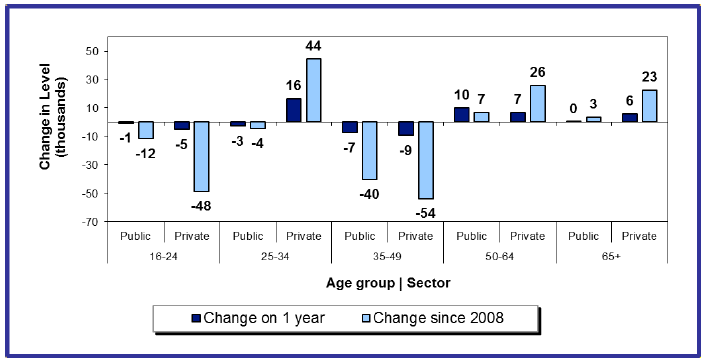
Source: Annual Population Survey, Jan-Dec 2013, ONS
From Chart 7, it can be seen that:
- The largest decrease over the year in public sector employment was seen in the 35-49 age groups (down 7,300).
- Employment within the public sector has fallen by 46,000 since the start of the recession in 2008, the majority of which was seen by the 35-49 age group (down 40,200). Both 50-64 and 65+ age groups saw an increase over this period, with the level, up 6,500 and 3,500 respectively.
- Over the year private sector employment increased by 15,000 overall. Private sector employment increased for the 25-34, 50-64 and 65+ age groups, up 16,500, 6,700 and 5,900 respectively. However the level decreased for the 16-24 and 35-49 age groups, down 5,100 and 9,000 respectively.
- Since the start of the recession in 2008, decreases in private sector employment were seen by the 16-24 and 35-49 age groups, down 48,500 and 53,600 respectively. The 25-34, 50-64 and 65+ age groups saw increases of 44,300, 25,600 and 22,500 respectively.
Contact
Email: Alan Winetrobe
There is a problem
Thanks for your feedback